Gun Violence

A gunman opened fire in a Lafayette, La., movie theater Thursday evening during a showing of Trainwreck, killing two and injuring nine, before turning the gun on himself, according to multiple news reports. Police say they know the identity of the shooter — described as a white, 58-year-old male — but are not yet releasing his name.
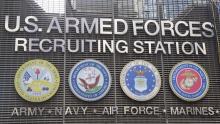
Four Marines were killed and one police officer wounded at a Naval Reserve center in Chattanooga, Tenn., on July 16, CNN reports.
The shooting occured at two sites — the first a military recruiting center — and lasted less than 30 minutes. According to CNN:
Investigators "have not determined whether it was an act of terrorism or whether it was a criminal act," Ed Reinhold, FBI special agent in charge, told reporters. "We are looking at every possible avenue, whether it was terrorism -- whether it was domestic, international -- or whether it was a simple, criminal act."
U.S. Attorney Bill Killian earlier told reporters that authorities were treating the shooting as an "act of domestic terrorism."
The suspected gunman is also dead. Read the full story here.

How could there have been people outside the South Carolina state house this weekend driving around in pick-up trucks with confederate flags attached to their beds, declaring "Heritage, not hate"? How could passerbys affirm these protests with shouts of "Long live the South"? How can people still deny that racism is deeply embedded in our culture? How can they not see that we must confront the harmful words and acts so that everyone may know they are beloved children of God and that their lives matter not just to God, but to their communities as well?
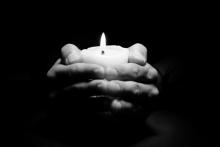
We are brokenhearted by the murders of nine parishioners at the Emanuel African Methodist Episcopal Church in Charleston, S.C. We join our brothers and sisters in deep lament for the lives lost in this evil act, and our prayers go out to all of the victims, their families and their communities.
Atrocities like this wound the very soul of our nation. We must not merely attribute this horror to the depraved actions of one individual, mourn those we have lost, and move on as if there is nothing more to do. In his statement yesterday, President Obama quoted Dr. Martin Luther King, Jr.'s words in the wake of the bombing of a black church in Birmingham, Alabama in which four little girls were killed:
"...We must be concerned not merely with who murdered [these girls], but about the system, the way of life, the philosophy which produced the murderers. Their death says to us that we must work passionately and unrelentingly for the realization of the American Dream."
The deep wounds of racism, America's original sin, still linger in our society, our institutions, and in our minds and hearts — sometimes explicitly, but far more pervasively through unconscious bias. Wednesday's terrorist act is the latest manifestation of this lingering sin. Are there no safe places for black people in our country, even the places where they come together to worship?
We all have the responsibility to overcome both the attitudes and the structures of racism in America. Today we mourn, but tomorrow we must act.
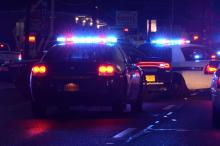
Last night while attending Sojourners’ annual conference, The Summit, I heard from Senator Elizabeth Warren, Jim Wallis, C.T. Vivian, and so many other legends in their fields. Afterwards, I stood in a small circle with others, discussing faith, justice, and reconciliation. I was the lone white face in my group of five; the other four were African-American, faith- and thought-leaders all.
One person, the only man in the group, referenced white supremacy. My ears perked up and I wondered, “Is that really a large part of the issue anymore?” I waited for a break in conversation so I could ask, “Aren’t we dealing more with subtle, insidious, and implicit biases these days?”
I never got the chance to ask. This morning at 5:00 a.m. when I picked up my phone to hit snooze, I saw an NPR alert: nine dead. I knew without question that those nine were black. Turing on CNN confirmed it, and I cried. No one had yet said the gunman was a white supremacist, but what else could he be? Who other than someone who feels his life supreme could take the lives of nine others, cause such aching disbelief and sorrow to their friends and family, and bring such hot pain to those around the nation who, like me, woke to tears and rage and confusion and heartache?

From 2001 through 2012, 6,410 women were murdered in the United States by an intimate partner using a gun. That is more than the total number of U.S. troops killed in action during the entirety of the Iraq and Afghanistan Wars combined.
Guns are used in fatal intimate partner violence more than any other weapon. Of all the women killed by intimate partners during 2001-2012, 55 percent were killed with guns.
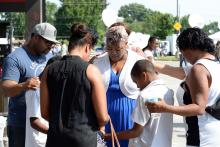
Mother, mother / There’s too many of you crying / Brother, brother, brother / There’s far too many of you dying —Marvin Gaye
then they stomped
John Willet
as he lay on the sidewalk
hands cuffed behind his back
and shot
Michael Brown
who was on his way this fall to college
Stop and frisk
Stop and frisk
and used a chokehold to kill
ON A COOL, windy October evening, the family of 23-year-old Dominic Amey Jr. stands outside and waits. They’re waiting for someone to tell them how and why Amey, a father of three, was shot and killed behind the house a week before. So they pray and they wait. But there aren’t any answers—at least none that night.
Joe Zelenka, a 74-year-old Catholic, wishes he had answers, but instead he offers the family what he has: prayers for peace and healing.
Zelenka has done this many times (probably too many times, if you ask him) since he began coordinating the Church Federation of Greater Indianapolis’ prayer vigils for homicide victims—many killed by gun violence—nearly 11 years ago. At every vigil, standing at the scene of the crime, Zelenka reads scripture, offers a prayer, and then invites those present to pray aloud if they so choose.
“I think it’s important that we bring God’s presence where violence has occurred,” he said. The vigils pre-date Zelenka’s tenure with the Church Federation—he’s the fourth person to hold the position of vigil coordinator since January 1996, when the Church Federation began holding a prayer vigil at the site of every violent homicide in the greater Indianapolis area.
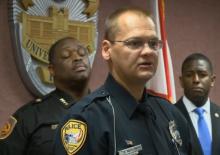
Early Thursday morning a gunman opened fire in a library at Florida State University, wounding three students before being fatally shot by police officers. Wielding a handgun, the shooter entered the library and forced hundreds of students studying for exams to flee or take cover behind bookshelves. NBC News reports:
FSU Police Department Chief David Perry said the library was “packed with students studying for final exams” and estimated that there were 300 to 400 people in the building. One group of students sought refuge behind rows of bookshelves. “Everyone started running to one side of the library, then to the back,” one 20-year-old communications student who asked not to be identified told NBC News. “People were saying, ‘Gun! There’s a shooter! Go! Go! Go!’" She said her group hid among bookcases for what she said felt like 20 minutes. Once given the all-clear, the group was escorted to a campus building next door where they stayed until 4 a.m.
Although the identity of the shooter is unknown, police officers believe he was acting alone and that there is no further threat to students at FSU.
In Dawn Cherie Araujo’s article, “Grace-Filled Moments” (Sojourners, January 2015), she explores the rising gun violence in Indianapolis and the ways local churches have taken stands to support families and rise up against the prevalence of grief in their communities.
What are groups like the Church Federation of Greater Indianapolis facing as they combat gun trafficking and violence? Check out the interactive infographic below and learn about the United States’ tumultuous relationship with guns. What are your state’s gun laws?
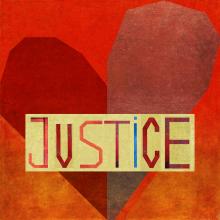
I am a professor of religion at a small liberal arts college in Decorah, Iowa. For the last two weeks in my Religion 239: Clamoring for Change course, students and I have been reading the book Occupy Religion: Theology of the Multitude. We have been discussing the issue of “justice,” and we have been playing with an image of God as one who works from the bottom-up on behalf of many rather than one who works from the top-down on behalf of a few.
A fundamental principle within this “bottom-up” theology is the idea of God taking sides (a view quite common in most of the “liberative” theologies). Many people, however, are often uncomfortable with the idea of God taking sides. They often assert that such an image contradicts the idea of an impartial and all-loving God who cares equally for all people.
A bottom-up theology of God asserts that God is a God who exists in relationship with all of creation at the same time every created thing is in relationship with every other created thing. While the relationships that involve human beings may be governed by several principles, I believe one principle that governs all human relationships is the principle of “justice.”
PARDEEP KALEKA and former white supremacist Arno Michaelis clasped hands during a radio interview on the first anniversary of a mass shooting that changed both of their lives. Their embrace was the ultimate symbol of brotherhood—two starkly different backgrounds united by a common goal of peace and understanding in an oftentimes cruel and unforgiving world.
Pardeep Kaleka is a member of the Sikh faith community. His father was one of the six worshippers killed on Aug. 5, 2012, at the Sikh temple, or gurdwara, in Oak Creek, Wis. Three more were injured that day before the man opening fire on the temple was wounded by the police. The gunman then prepared for one final pull of the trigger, taking his own life.
The shooter was Wade Michael Page, a white supremacist, acting on his own volition that Sunday morning. He had spent his life practicing violence and hatred toward all kinds of people he felt to be “different” from him. This hatred culminated in a final unthinkable act, killing six people in cold blood at their holy place of worship.
There was angst, confusion, and grief among the Wisconsin Sikh community after this terrible tragedy. But where many may have expected anger from those most deeply affected, the Sikhs responded with something thoroughly refreshing: peace.
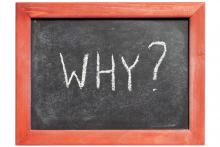
Last week’s school shooting in Marysville, Wash., has us all asking the question again: Why did this happen?
Snohomish County Sheriff Ty Trenary gave voice to the despair many are feeling as we search for answers. “The question everybody wants is ‘Why?’ I don’t know that the ‘why’ is something we can provide.”
Why did Jaylen Fryberg text his friends and family members to join him for lunch only to shoot them and then shoot himself? Whenever these tragedies occur we are tempted to blame the shooter by making him into a monster. We label the shooter “mentally ill,” claim that he was isolated from his peers, or was a generally troubled youth.
The answer to the question “Why?” has usually been to blame the shooter. We make the shooter into a monster because it allows us to make sense of senseless violence. Why did this tragedy happen? Because he was evil.
But Fryberg’s case won’t allow such easy answers. By all accounts, he was a popular and happy young man, seemingly incapable of causing such harm.
This horrific shooting is so scary because no one saw it coming. If a popular kid like could commit such a heinous act, anyone could do the same. Fryberg’s case deprives us of the easy out of blaming another. The only thing left is to face our own violence.

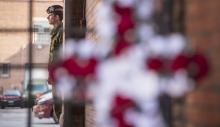
Yesterday a gunman opened fire in Ottawa and killed a soldier at a war memorial. It is a stark reminder of the kind of world we live in every time a life is taken through violence. My prayers are with the victim and his family and for the authorities leading the investigation in trying to understand the shooter’s motives.
Like Ebola and ISIS, the shooting is spreading fear around the world. It is not unnatural to experience fear as a reaction to danger. However, reacting out of fear instead of wisdom is the mistake we must stop making.
What happened in Ottawa is also a reminder for me that while we can’t remove all violence, we can take steps as a country to reduce it. In 2011, the last year complete numbers are available, 32,163 died in America due to gun related deaths. In Canada that same year the number was 781. While gun violence can happen anywhere, as Ottawa shows, it happens much more in the United States than any other developed country.
Why the discrepancy? The full answer is complicated, but one of the driving factors is not.
A Sandy Hook Father’s Plea from Sojourners on Vimeo.

Michael Brown. Sandy Hook. Trayvon Martin. Aurora. Columbine.
Within the last decade, the narrative of children and teenagers being killed by gun violence has become an all-too-familiar narrative in the American public sphere. In a recent report compiled by The Brady Campaign, statistics revealed that in 2011 alone, 19,403 children were shot and 2,703 children and teenagers lost their lives to guns.
That’s seven of America’s youth under the age of 20 killed every day.
In the book of Matthew, the disciples ask Jesus, “Who is the greatest in the kingdom of heaven?”
Jesus calls a child to join the group.
“Truly I tell you, unless you change and become like children, you will never enter the kingdom of heaven,” he answers.
If as Christians, children represent God’s creation in its most pure and innocent form, why is it that as Americans, we continue to let children die preventable deaths from gun violence? Gun control policies are a difficult discourse for the American public. Yet one thing we can all agree on is that children should not be killed.
Of the 2,703 children killed in 2011, 61 percent were homicides, 32 percent were suicides and 5 percent were unintentional shooting. These statistics propel gun-related deaths to the number two leading cause of death for youth in America.
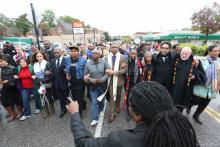
Thousands of people from around the country came to Ferguson, Mo., for a “weekend of resistance.” But for faith leaders it was a weekend of repentance. Twenty of us were arrested in Ferguson yesterday for an act of repentance.
I went to Ferguson as a faith leader but, in particular, as a white faith leader. Because the great disparity between how differently young black lives are treated in our criminal justice system than young white lives is a fundamental injustice that must not only be left to black faith leaders to raise up. Repentance must begin in the white Christian community for tolerating this offense to our black brothers and sisters and, ultimately, this offense to God. Let me be as honest as I can be. If white Christians in America were more Christian than white, black parents could feel safer about their children. It’s time for us white Christians to repent — turn around and go in a new direction.
Repentance is a powerful theme throughout the Bible. But its meaning is often not well understood. Repentance is not about being sorry or just feeling guilty. It is about turning in a new direction. The biblical word for repentance in the original Greek is metanoia, which means you are going in the wrong direction, and it’s time to turn right around.
In the case of Ferguson, repentance means more than merely acknowledging the tragic death of an unarmed 18-year-old African-African man named Michael Brown on Aug. 9 — shot and killed by a white police officer named Darren Wilson. Repentance means more than lamenting the loss of another young black man or being sympathetic to his grieving mother. True repentance means changing the direction of the practices and policies that led to his death and so many others.

It is frightening to consider that within the context of violence against women, little has progressed since the time of the Old Testament. Currently, 1-in-3 U.S. women will experience intimate partner violence throughout her lifetime. Even more frightening is that every month, 46 women are killed by an intimate partner with a gun.
Americans across partisan, personal, and religious lines are divided on the role of the Second Amendment in the public square. Yet no matter ones’ stance on gun control procedures, one fact transcends opinion: women are at a higher risk for intimate partner gun violence than men.
From 2001 through 2012, 6,410 women were murdered in the United States by an intimate partner using a gun — more than the total number of U.S. troops killed in action during the entirety of the Iraq and Afghanistan wars combined. The rate at which domestic violence turns to murder is a harsh reality — and when a domestic abuser has a gun, a victim is 12 times more likely to die than when the abuser doesn’t.
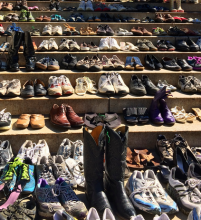
The empty shoes came in all shapes and sizes — cowboy boots and sneakers, children’s sparkly shoes and women’s dress shoes. They filled step after step going up toward the entrance of the Wisconsin State Capitol.
The shoes — 467 pair of them — represented the death toll from guns in just one state: Wisconsin.
"I want you to look at these empty shoes," Jeri Bonavia, told the crowd gathered on the Capitol steps on Monday. "I want you to bear witness. All across our state, families are aching with emptiness."
Bonavia is the executive director of the Wisconsin Anti-Violence Effort, which is using this display of empty shoes in five cities around the state this week.
In the nationwide scheme of things, Wisconsin has a lower death rate from guns than the nation as a whole. The annual average of 467 from murder, suicide and accidents is just a fraction of the approximately 30,000 gun deaths each year across the U.S.
And yet the row upon row of empty shoes on the steps spoke to the heartache that comes with each death, whatever the toll in whatever state.
